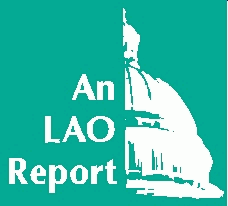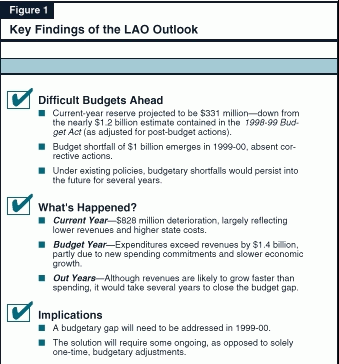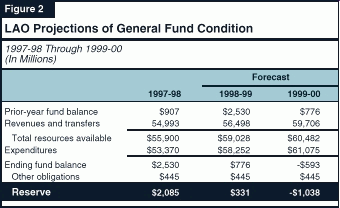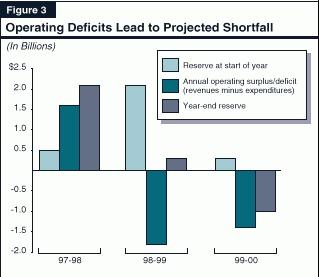
 |
California's Fiscal Outlook
|
In striking contrast to the past two years, when strong revenues provided funds for both tax relief and significant spending increases in education and other program areas, our projections indicate that 1999-00 will be a difficult year. In fact, significant budgetary adjustments will be needed to keep the General Fund budget in balance. Figure 1 summarizes our key findings, while Figure 2 (see page 2) presents our estimates of the state's General Fund condition.


As indicated in these two figures, we estimate that the current year will end with a reserve of $331 million, or $828 million less than the 1998-99 Budget Act estimate of nearly $1.2 billion. With regard to the budget year, we estimate that expenditures will exceed revenues by nearly $1.4 billion, leading to a 1999-00 year-end deficit of over $1 billion absent corrective actions. Our longer-term forecast of revenues and expenditures indicates that the imbalance between revenues and expenditures will persist beyond the budget year, under current-law policies.
Our initial assessment of the budgetary outlook for 1999-00 is in stark contrast to the past two years, when the state had significant budget surpluses. The main reasons behind this change are a less optimistic revenue outlook, higher than anticipated current-year program costs, and significant expenditure increases that would occur under existing law in 1999-00.
Economic Outlook. The 1998-99 budget adopted last summer was based on the administration's economic projections for 1998-99 and beyond, which assumed continued strong growth in the economy and healthy stock market-related increases in capital gains revenues. Current economic trends, while clearly more positive than a month or two ago, still suggest that Asia's economic problems and mixed performance in the U.S. stock market will lead to more restrained economic increases than the administration assumed last Mayparticularly in late 1998 and early 1999. Specifically, we project that California personal income growth will slow from 6.8 percent in 1998 to 5.2 percent in 1999, before partially rebounding to about 5.5 percent in 2000. These estimates compare to the administration's earlier projected increases of 7.2 percent, 5.7 percent, and 5.0 percent, respectively.
Revenue Outlook. We forecast that General Fund revenues will increase from $55 billion in 1997-98, to $56.5 billion in 1998-99, and $59.7 billion in 1999-00. Our updated projections take into account the effects of the slowdown in California's economy as well as the impacts of the tax relief packages enacted in both 1997 and 1998. Together, these packages will lower revenues by $1.4 billion in both the current and budget years.
Our updated revenue estimate for 1998-99 is nearly identical to our May 1998 estimate (as adjusted for the 1998 tax relief package that was adopted after our May estimate was prepared). However, it is down $485 million from the administration's 1998-99 Budget Act forecast. For 1999-00, our current revenue forecast is $173 million below our May projection, and is down by $1.2 billion from the administration's estimate. Our lower revenue forecast relative to the administration's reflects our expectation of slower income growth in California. It also reflects the impact of the stock market's recent losses on such factors as bonuses, stock options, and investment earnings, all of which have contributed to the major revenue gains experienced in recent years.
Over the longer term (from 1999-00 through 2003-04), we project that total General Fund revenues and transfers will increase by about 5.7 percent per year, or roughly similar to statewide personal income growth.
Additional VLF Reductions Not Triggered. As discussed in Chapter 4, the Vehicle License Fee (VLF) tax reduction measure passed earlier this year provided for a 25 percent reduction in the VLF rate. This measure specified that additional VLF reductions could occur beginning in 2000-01, if revenues exceed the Department of Finance's May 1998 revenue forecast by at least $1.5 billion. Our long-term revenue forecast remains well below the trigger threshold through the forecast period. Thus, based on our projections, additional VLF reductions would not be triggered.
The 1998-99 Budget Act, as adjusted for post-budget legislation, assumed total revenues of $56.4 billion, expenditures of $57.8 billion, and a year-end reserve of $1.2 billion. Compared to the budget act, our estimate of current-year revenues is down $485 million and our estimate of current-year expenditures is up $493 million. Together, these two factors primarily are responsible for an $828 million reduction in the reserve, down to $331 million.
On the revenue side, most of the difference from the budget act relates to our lower estimate of personal income taxes, which in turn reflects our less optimistic assumptions about personal income growth and capital gains levels in 1998 and 1999.
On the expenditure side, $316 million of our higher costs are due to the Medi-Cal program, which is being affected by higher caseloads, a court injunction requiring continued payments for prenatal benefits to undocumented immigrants, and provider rate increases. Other factors raising current-year expenditures include reduced federal reimbursements for social services and corrections programs, likely increases in fire suppression costs, and increased local property tax administration reimbursements.
Basis for Our Estimates. Our revenue and expenditure forecasts for 1999-00 and beyond are based primarily on the requirements of current law. Specifically, we have adjusted the 1998-99 spending plan for constitutional and statutory funding requirements, as well as for projected changes in caseloads and inflation factors. For example, we have increased K-14 education funding in line with the Proposition 98 minimum funding guarantee. Spending for higher education is adjusted each year for projected changes in enrollments and inflation. Our estimates for California Work Opportunity and Responsibility to Kids (CalWORKs) and Supplemental Security Income/State Supplementary Program (SSI/SSP) incorporate cost-of-living adjustments (COLAs), as provided for in the 1998-99 Budget Act and trailer bills. With regard to state employee compensation, we have included costs associated with the bargaining agreements reached with the four bargaining units to date. We also have included additional COLA adjustments for all state employees equal to inflation for 1999-00 and subsequent years.
Our fiscal estimates are not predictions of what the Legislature and Governor will adopt as policies and funding levels in coming budgets. Nor are they our recommendations of what tax and spending policies ought to be. Rather, our estimates are a baseline projection of what would happen if current policies were allowed to run their course. We believe that by using this approach, our forecasts provide a meaningful starting point for the Legislature's evaluation of the state's fiscal condition.
Our Forecast. As indicated in Figure 2, we project revenues to total $59.7 billion in 1999-00, or about $1.4 billion less than the $61.1 billion in expenditures that we forecast for the year. As a result of this imbalance, the remainder of the current-year's reserve would be "used up" and the 1999-00 fiscal year would close with a deficit of slightly over $1 billion.
The key reason behind the deterioration in the state's projected fiscal condition is the emergence of a large and ongoing shortfall between revenues and expenditures, beginning in the current year. Figure 3 shows for 1997-98 through 1999-00 the relationship between the budget's carry-in reserve at the start of each year, its annual "operating balance" for each year (that is, revenues minus expenditures), and the year-end reserve for each year.

1997-98 Developments. Figure 3 shows that in 1997-98, the state began the year with an incoming reserve of $0.5 billion. In addition, revenues for the year exceeded expenditures by $1.6 billion (due to the much stronger-than-expected revenues received in April 1998). In other words, the state ran an "operating surplus" within the year. Added together, these two factors (the positive carry-in balance and the operating surplus) led to a year-end reserve of $2.1 billion, which was available at the beginning of 1998-99.
1998-99 Developments. In 1998-99, however, the state will spend more than it receives in revenues, resulting in an annual operating deficit of $1.8 billion during the year. This operating deficit will "draw down" the reserve from $2.1 billion at the start of the year to $331 million at the close of the year.
About $800 million of the state's $1.8 billion 1998-99 operating deficit was anticipated in the 1998-99 Budget Act. This anticipated portion represented a planned drawing down of the reserve to support one-time expenditures for such purposes as resources, prison capacity expansion, and other forms of capital outlay. However, the remaining $1 billion of the $1.8 billion current-year operating deficit is due to unanticipated eventsspecifically, lower-than-anticipated revenues and higher-than-anticipated state costs.
1999-00 Developments. We forecast that the operating deficit will shrink modestly, from $1.8 billion in the current year to $1.4 billion in 1999-00. This occurs because the budget-year revenue growth ($3.2 billion) will be greater than expenditure growth ($2.8 billion).
Unlike in the current-year, however, the budget year cannot offset its operating deficit with a large carry-in reserve, since the 1999-00 carry-in reserve is only $331 million. Thus, the persistence of the still-large operating deficit causes the General Fund's year-end reserve to fall further in the budget year, to a deficit of about $1 billion.
The emergence of large operating deficits in both 1998-99 and 1999-00 is related to three factors.
The actual level of revenues, expenditures, and year-end reserves for future years will depend on a variety of factors, including actions taken by the Legislature and the administration to bring the 1999-00 budget into balance.
In theory, the 1999-00 budget could be brought into balance by reliance on either one-time or permanent adjustments to expenditures and/or revenues However, our long-term projections of revenues and expenditures under current law indicate that the current-law imbalance between annual revenues and expenditures would persist for several years. As a consequence, it will be important that actions taken to keep the 1999-00 budget in balance include various permanentas opposed to solely one-timebudgetary actions.
This is underscored by the fact that our projections are based on continued economic expansion, and thus do not allow for disruptions to revenues that would accompany a pronounced economic slowdown or downturn. Ideally, one would be able to rely on a budgetary reserve to at least partially deal with this or other contingencies. However, because of the budget problem we foresee, no reserve would be available.
Continue to Chapter 2: Economic and Demographic Projections